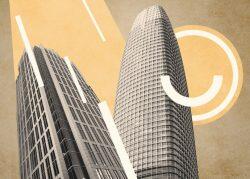A crop of new commercial reports about San Francisco came out during the last few weeks, all bearing witness to just how severely the work-from-home trend has upended the office market nearly three years after the pandemic started, with vacancy levels at new highs and trade volume and rents at their lowest levels in a decade or more.
Or, as Paypal Mafia vet and Yammer founder David Sacks put it in a recent Tweet that got about 10 million views: “Just got offered office space in San Francisco (SOMA) for the same price as 2009. Yikes.”
To which Elon Musk replied: “It will go lower.”
To a large extent, commercial data analysts and agents agreed.
“The prevailing expectation is that the SF market will continue to struggle during 2023 and that the market has not yet hit bottom as signs of recovery are not anticipated until early 2024,” said Gary Baragona, research director at Kidder Mathews, via email.
Vacancy rising
Direct office vacancy rose to 18.4 percent in the fourth quarter, according to Kidder Mathews data, a figure Baragona said has not been reached since the 1990s, when the direct vacancy rate was 19 percent. On top of that, sublease vacancy rose again in the fourth quarter and is now 5.3 percent. Transwestern fourth-quarter figures pinned the sublease number even higher, at 9.5 percent, or about 8.6 million square feet, for an overall vacancy rate of 23.7 percent.
As a point of comparison, the office market had a vacancy rate of 5 percent before the pandemic, Baragona said.
As far as rents as low as 2009 in SOMA, that may be a bit of an exaggeration. The Kidder Mathews data shows SOMA rents dropping to about $60 in the fourth quarter of last year, an 11 percent decline year-over-year and a drop of 12 percent since the most recent high before the pandemic hit in 2020. In 2009, there were subleases in the $20s and direct leases in the $40s and up, according to Paul Picciani, office tenant advisory specialist at Kidder.
Picciani doesn’t expect rents to rise for at least the next year and, unlike in 2009, he said via email that low building occupancy isn’t the result of a recession but “a definite trend toward WFH and much lower pressure to be in the office.”
The ongoing popularity of work from home, especially in tech, has made this down cycle different from the last two, agreed Colin Yasukochi, who leads research at CBRE. After the dot-com bust and the financial crisis, it took two to three years to recover, he said via email, and rents went up and down in step with demand.
This time, macroeconomic factors are just part of the equation, with uncertainty over the workplace the major driver in what CBRE figures show as a total of 27.6 percent office vacancy, with about half of all office space available in submarkets like West SOMA and Yerba Buena. Mission Bay is the most in-demand market and yet it still has a quarter of all office space available.
On top of increases in remote work, the office market must also contend with a string of high-profile tech layoffs, including Twitter, Meta and, most recently, Salesforce. Avison Young data shows that one-third of Bay Area tech layoffs in 2022 struck San Francisco employees and that in September the city had the second-largest decline of job postings among the top 20 U.S. office markets, behind only Seattle, “due to the contraction of the tech sector,” according to its fourth-quarter report.
Flight to quality
Emphasizing the “flight to quality” trend, Avison Young data shows that trophy properties have had more visitor volume compared with other office types, but even then volume is at only 50 percent of pre-pandemic levels. Still, that is the best foot traffic in the city, with Class A buildings showing visits at 45 percent of pre-pandemic levels and Class B buildings at just 20 percent in mid-December.
Trophy buildings command significantly higher rates, at $107 per square foot, which is even higher than its previous $105 peak for net effective rents, as employers hope views, amenities and prime locations will lure employees back to the office. For Class A buildings, asking rents peaked a more than $90 in mid-2020 but were at about $83 per square foot in the fourth quarter of 2022. Class B asking rents showed a similar decline, breaking $80 per square foot in the first half of 2020, compared with $70 in the most recent data, according to Avison Young.
TransWestern found that overall rents in the city closed the fourth quarter at $54.24 per square foot, down 2 percent from the third quarter and an even further fall from the pre-pandemic peak of $73.63 per square foot. Since the start of 2020, according to TransWestern, total net absorption has been negative 13.5 million square feet.
A drop of more than 4.2 million square feet occurred in 2022 alone, according to Colliers data, with the fourth quarter registering negative 800,000 square feet of net absorption. SOMA West, Union Square, Yerba Buena and Potrero West all saw positive net absorption at the end of the quarter, while “downsizes in tech and professional services” made the North Financial District the greatest contributor to the negative trend with 415,000 square feet put back on the market in the fourth quarter.
Uncertainty in the market and rising interest rates resulted in only three closed office transactions in the fourth quarter, according to the Colliers report, all less than $10 million. In 2022, only $700 million in commercial assets changed hands, the lowest figure since 2009.
Long-term optimism
The numbers may sound dire, but some agents who take a long-term view have posited that the current round of tech layoffs may lead to tomorrow’s unicorn startups. Avison Young’s data head Dina Gouveia said via email that “we anticipate the market to adapt and transform, similar to other downturns” and CBRE’s Yasukochi said San Francisco has a habit of creating new industries in times of transition that end up lifting the entire market.
“After the great financial crisis in 2008-2009, the on-demand sharing economy began to take off and led to a fivefold increase in tech industry employment,” he said. “We will likely see some new growth spurt occur a couple years from now and I’m optimistic about the longevity of the tech industry and future of downtown San Francisco.”
Read more



